The one person who above all others enabled us to track down the official Nazi art looters and to engage intelligently in that aspect of the whole picture was Mademoiselle Rose Valland, a rugged, painstaking and deliberate scholar. This girl was an assistant at the Jeu de Paume when the Germans arrived and converted the building into the central clearing house for the finest of the confiscated works of art. She told me that judging from what she personally had observed, the Germans had taken one-third of the privately owned art from France. Throughout the war, and in the absence of the director, she stayed at her post in the museum. Time and time again the Germans tried to discourage her presence. She was led to the door with a frequency that bordered on the comic; but each time she disregarded their orders and returned to the museum. Her blind devotion to French art made no allowance for any thoughts of personal danger (J. Rorimer, 109).
…At night she would sneak out the negatives which the Germans had developed during the day. She had prints made and then returned the negatives to the files the following morning. With imprisonment in a concentration camp, or death, the penalty if she were caught, she had been fortunate. Even the watchman’s logbook, which had the names of all the visitors to the Jeu de Paume for more than a four-year period, had come into her possession (J. Rorimer 111).
Rose Valland knew “where…the works of art that were removed to Germany [had] been secreted” and she shared her information with my grandfather and the SHAEF Mission to France (J. Rorimer 114).
“You must go to Germany, James,” she said. “I’ll join you as soon as I can, but you must go right away”…”[T]he Nazis have collected and catalogued their booty…In the castles of Neuschwanstein and Hohenschwangau” (J. Rorimer 112, 114).
Before I go to Germany tomorrow, allow me to recount my experiences retracing the footsteps of Rose Valland in Paris.
For me, the obvious first step was to inspect the outside of the Jeu de Paume. The building is located on the Place de la Concorde, at the edge of the Tuileries Gardens. There, I found the following plaque, dedicated to Rose Valland. (I welcome my readers to translate this plaque by responding to this post in a comment)!
I figured that if there was a plaque dedicated to Rose Valland, surely the museum folks inside would know something about her story. So, I entered the museum, approached the ticket booth, and began my prepared dialogue in French.
I did my Monuments Girl spiel, showing the picture post-card with my grandfather’s image, then my grandfather’s book, next a copy of “The Monuments Men,” and finally my blog business card. The cashier informed me that the building is now a private gallery devoted to contemporary photography, and she directed me to the museum book shop. The librarian at the book shop showed me Rose Valland’s memoir and another book of her complete notes, both in French. Then, almost as an afterthought, he pointed out a children’s picture book in French entitled, “Rose Valland, l’espionne du musée du Jeu de Paume.” At the bottom, I read, “L’HISTOIRE EN IMAGES.” I was elated! It was the perfect reading level for me with my beginning French skills! I paged through the book looking for a cartoon character of my grandfather. He wasn’t there, but I did find an equally exciting part, a two-page spread of the German soldiers captured in the courtyard of the Louvre! I knew that scene already from reading my grandfather’s account! (See my previous post on “The Liberation of Paris). I didn’t hesitate to make my purchase.
To round out the heroic story of Rose Valland, fast forward to 1955, the year my grandfather was appointed as the Director of the Metropolitan Museum of Art. Below is the congratulatory letter he received from Valland. (If you can’t read French, there is an English translation provided below). My favorite part is Valland’s reference to “justice,” since so many of my grandfather’s wartime letters mention his struggle with the military hierarchy and trying to get things done being ranked as a 2nd Lieutenant.

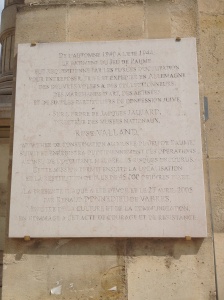
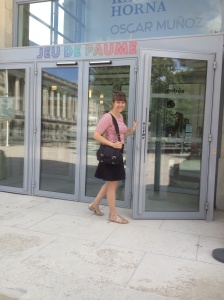
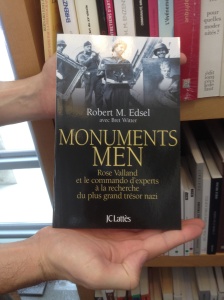
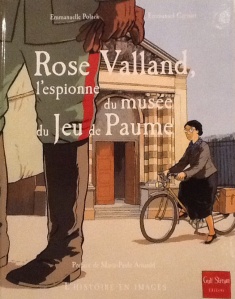
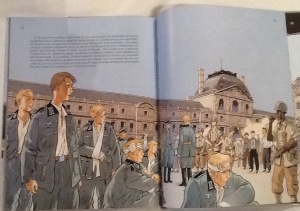
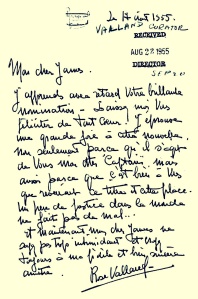
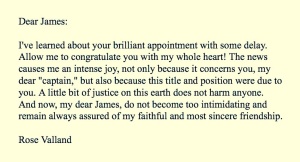
Sarah, How can each of us who receive these reports from you fail to be impressed by the intensity and volume of your research. I am a recent novice in the French language, and admire your effort. I plan to share much of this with my daughter, who is fluent in French, and had spent a summer in Fontainebleu studying music with the Casadesus family long ago.
Thank you for your kind words, Dr. Engel! All I can say, is that I’ve had just the right things at just the right times, and everyone that I’ve reached out to for help has been incredibly responsive and generous. For this, I am very grateful! I’m only using my iPad and iPhone to put things together, and since my documents are digital, it works! Thank you for reading!!!
Sarah, My “Comments” would not post so am hastening to say that it is terribly exciting to have Rose Valland enter the story. How gracious her letter to your Grandfather is – just marvelous! Ah, really super to hear about through your eyes! love, Nan
Thanks again for reading Nan! It has been a very exciting few days here in Paris! Tomorrow, I head for Neuschwanstein!
What a great post! I love seeing all the handwritten letters you post and knowing that you found a children’s book that tells Rose’s story. What a courageous woman to risk her life, just like your grandfather, so that we all had art to inspire us for years to come. I can see why the two of them became good colleagues in pursuit of their shared mission.
Thank you for following and commenting Allison! History is alive!!!
Sarah, your writings are fascinating.
Thank you Bonnie! So glad you are reading and enjoying!
Sarah, hi, Brag had fun translating this plaque for you.
From the autumn of 1940 to the summer of 1944 the building of the Jeu de Paume was requisitioned by the occupying forces for temporary storage, crating and shipping to Germany of works of art stolen from collectors and dealers, artists and private Jewish owners. At the direction of Jacques Jaujard, director of national museums, Rose Valland, conservationist at the Museum of the Jeu de Paume, followed and recorded these operations unbeknownst to the occupiers. Notwithstanding the risks incurred, this mission enabled in due course the location and restitution of more than 45,000 works of art. This placque was unveiled on April 27, 2005, by Renaud Donnedlieu de Vabres, Minister of Culture and Communication, in recognition of that act of courage and resistance.
As the archivist who processed the James Rorimer papers at The Metropolitan Museum of Art this year, I’m delighted that you were able to include one of Rose Valland’s letters from the collection as part of your wonderful explorations here. She wrote an equally heartfelt and moving letter of condolence to your grandmother after JJR’s sudden death in 1966. There was obviously deep mutual respect between these two ardent protectors and promoters of cultural heritage. Looking forward to reading more of your travels!
Celia, thank you for uncovering this gem of a letter! I look forward to reading her 1966 letter to my grandmother when I get back to NYC. After all of your work, you must have the feeling that you know my grandfather well 🙂